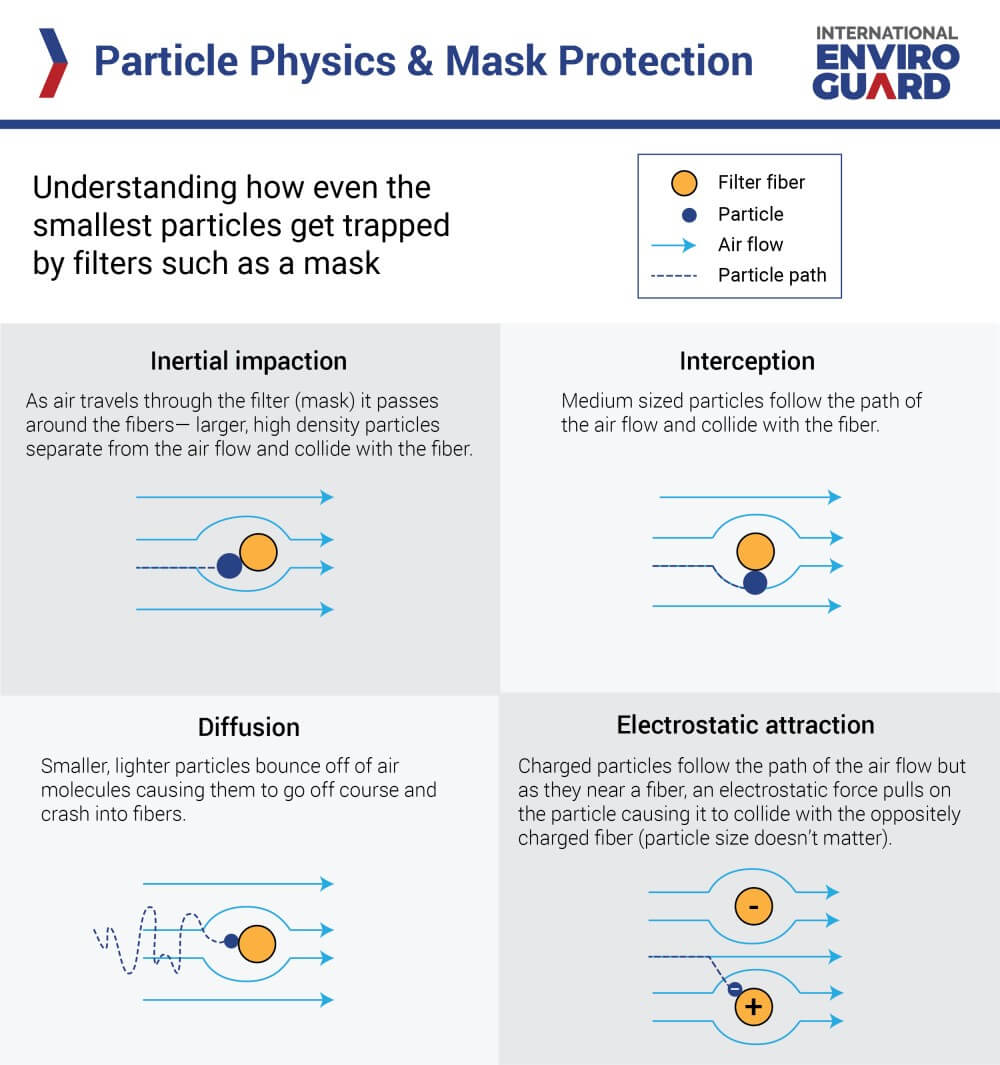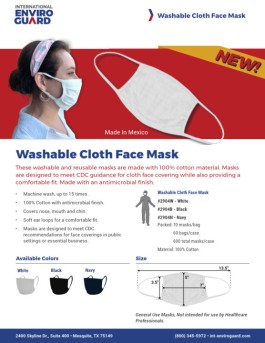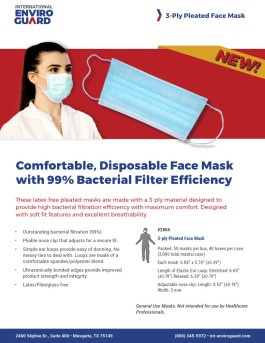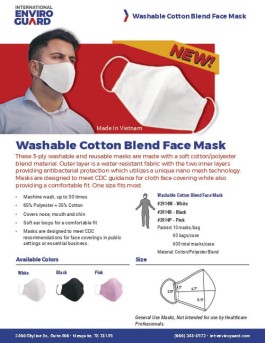
The COVID Virus is Much Smaller Than 0.3 Microns Wide—Here's How That Impacts Mask Safety
All around us, the air is full of small solid and liquid particles that are easy for humans to inhale or ingest. Scientists classify these airborne particles by diameter size in units called microns (micrometers). One particle size, PM0.3, has recently become a source of greater discussion during the global COVID-19 pandemic. This has led many people to wonder: what is PM0.3 and why is it so important?
Keep reading to learn more about PM0.3 and coronavirus and discover the cost-effective strategies you can employ at your organization to keep your workforce safer.
A Quick Primer on Particulate Matter, Air Pollution, and Human Health
Particulate matter (PM) is a broad term used to refer to airborne pollutants or contaminants—those small bits of solids or liquid droplets that circulate throughout the air.
Particulate matter comes not only from industrial sources like factories, construction sites, mines, and power plants, but also vehicle emissions and additional fuel-burning activities. Even natural sources, such as wildfires, wood burning stoves, pollinating plants, and unpaved dirt roads, can emit particulate matter into indoor or outdoor air.
Examples of PM include dust, smoke, soot, pollen, mold spores, vehicle exhaust, dirt, and yes—bacteria and viruses. And as we've seen during the novel coronavirus pandemic, short- and long-term exposure to airborne particles can lead to negative or even serious health effects, even if these particles can't be seen by the naked eye.
What Are the Particulate Matter Categories?
As mentioned, scientists typically classify airborne particles by size. They use two main categories to do this: PM10 and PM2.5. Recently, more attention has been paid to other particle sizes, as well, including PM0.3 and PM.01.
PM10
Particles that fall into the PM10 category are generally 10 microns or smaller in diameter (a micron is 1 millionth of a meter, or 1 one-thousandth of a millimeter). Examples include dust, pollen, and mold. For reference, the diameter of a single strand of human hair is about 50 to 70 microns...so even particles in the "largest" PM category are still incredibly small!
Just because these particles are larger and sometimes visible doesn't necessarily mean they're harmless. Particles within the PM10 category can cause nose and throat irritation, allergic reactions, asthma attacks, bronchitis, impaired lung function, and (with chronic exposure) an increased risk of diseases like lung cancer, stroke, heart attack, and high blood pressure.
PM2.5
The second PM category, PM2.5, contains particle sizes that are about 2.5 microns in diameter or less. Examples include combustion particles, heavy metals, and organic compounds like bacteria and viruses. Technically speaking PM2.5 particles fall within the PM10 category since PM10 includes anything 10 microns or smaller.
But particles as tiny as 2.5 microns or less are thought to be even more dangerous than larger particles because they can penetrate your lung tissue more deeply and seep into the bloodstream—and therefore easily circulate to the brain and other areas of the body.
This increased ease of access into human tissues helps explain why exposure to PM2.5 pollutants and contaminants have been linked to impaired immune function, congenital abnormalities, decreased brain volume, diabetes, and premature death, in addition to all the other health problems posed by PM10 pollutants. In fact, particulate matter that measure 2.5 microns and smaller account for the largest proportion of adverse health effects caused by air pollution, according to the World Health Organization.
Even smaller particles, those ranging from PM0.3 to PM0.1, include ultra-fine dust and viruses. These have also been linked to negative health consequences, although there's less data about them compared to particles classified within PM10 and PM2.5.
Because of the negative health consequences of short-term and long-term exposure to some of these particles, many industries require the use of protective face masks and other personal protective equipment (PPE) that will trap these particles and prevent the wearer from inhaling them. But as it turns out, not all PPE can effectively protect against all PM categories.
What Size Are Coronavirus Particles?
SARS-CoV-2, the virus that causes the disease COVID-19, is small—very small. Its typical diameter ranges from 0.06 to 0.14 microns.
How PM0.3 Relates to Mask Safety (And How N95s Work Against COVID-19)
Once the pandemic was well under way, public health officials began urging people to wear face masks to reduce the spread of COVID-19. But there has been some confusion over whether masks are effective for protecting against such a small virus like SARS-CoV-2.
Much of this confusion came from the fact that N95 respirators are only rated to block particles with diameters of 0.3 microns or larger (PM0.3). Given that this is the true, people wondered, how would an N95 protect the wearer against an even smaller particle like the coronavirus, which has a typical diameter of 0.1 microns?
To clear up the confusion and understand why N95 respirators and even other masks are likely to help prevent the spread of COVID-19, three key points should be clarified.
First, very small particles move differently than larger particles on account of physics. Second, tiny viruses don't travel solo—they're contained within larger droplets that can be blocked by N-95 masks and even most surgical or cloth masks. Third, N95s contain specialized fibers that are capable of holding an electrostatic charge which can trap oppositely charged particles and make it very difficult for them to escape.
1. Particulate Matter Less Than 0.3 Microns Wide (Like SARS-CoV-2) Moves Erratically
There's an interesting principle in physics known as Brownian movement, aka pedesis, that helps explain why N95 respirators can help block SARS-CoV-2.
Put simply, Brownian movement refers to the random movement of particles suspended in a medium, such as air. Under the Brownian movement phenomenon, particles smaller than 0.3 microns move in erratic, zig-zag patterns. This is because they are small enough and have so little mass that they collide with gas molecules and bounce around in multiple directions. This erratic movement actually increases the chances that these very small particles, including SARS-CoV-2 viruses, will bounce against mask fibers and get stuck instead of flying straight through.
Meanwhile, particle sizes larger than 0.3 microns tend to move in more predictable straight lines and respond effectively to N95 filtration.
Interestingly, research suggests that particles larger and smaller than 0.3 microns are blocked the most efficiently by N95s, whereas particles that are exactly 0.3 microns in diameter tend to be harder to capture since they lie in between these two parameters. For this reason, researchers have called 0.3 microns the most penetrating particle size, or MPPS.
2. Small Viruses Bind to Larger Respiratory Droplets
While it's true that coronaviruses are incredibly small, they aren't floating around freely in the air. SARS-CoV-2 particles are contained within aerosolized respiratory droplets that get exhaled by an infected person when they breathe, cough, sneeze, or talk. These droplets are typically 0.3 microns or larger. Since N95s are capable of blocking particles measuring 0.3 microns or larger, the virus particles contained within these droplets are less likely to get past the respirators.
Even cloth masks and surgical masks, when worn correctly, can help block large-particle respiratory droplets infected by SARS-CoV-2 and therefore help prevent the spread of the disease, although they won't offer the same amount of protection as an N95 for fine particles.
3. N-95 Masks Use Electrostatic Attraction to Trap Oppositely Charged Particles
One other reason why N-95 masks in particular work well against preventing the spread of SARS-CoV-2 is that these masks are specially designed to induce a phenomenon known as electrostatic attraction.
Embedded within N95s are synthetic fibers that can hold a sufficiently strong electrostatic charge. This charge attracts oppositely charged particles, even small ones, thereby trapping them against the fibers. Unfortunately, cleaning and storing N-95 masks appears to reduce this electrostatic mechanism, which is one reason why manufacturers generally don't recommend reusing them.
The graphic below outlines particle filtration in terms of particle size and the physics behind it to help you better understand mask filtration efficiency.

Is There A Difference Between a PM0.3 Mask vs N95 Mask?
We just learned that a diameter of 0.3 microns has been recognized as the most penetrating particle size for filtration systems like N95 respirators. Understanding this benchmark can actually help you understand the connection between a PM0.3 mask vs N95 mask. They're essentially the same thing, in that a N95 can block 95% of all particles that are 0.3 microns and larger—although, as we've learned, it also seems likely that N95s can block smaller viruses, too, thanks to Brownian movement phenomenon and electrostatic attraction.
Conclusion
Particulate matter (liquid or solid particles in air) includes dust, pollen, mold, smoke, metals, bacteria, and viruses. Some of these particles can cause harmful effects to human health, whether through short-term or long-term exposure. Understanding the size of these different types of particulate matter is important when it comes to protecting public health from air pollution and the spread of infectious diseases like COVID-19.
Particulate matter categories include PM10, PM2.5 and PM0.3—solid or liquid airborne particles with diameters of 10 microns or less, 2.5 microns or less, and 0.3 microns or less, respectively. N95 respirator masks, which are common PPE for health care workers who are caring for patients sick with COVID-19, are able to block 95% of all particulate matter that is 0.3 microns or larger.
According to the Centers for Disease Control and Prevention (CDC), the SARS-CoV-2 virus is smaller than this (ranging from 0.06 to 0.14 microns in width). Many people have worried that N95s can't adequately protect the wearer from COVID-19. Fortunately, there are several principles at play that help explain why N-95 masks and even surgical or cloth masks help reduce the spread of coronavirus.
Of course, SARS-CoV-2 and other types of viral infections aren't the only reason why you or your workforce may need to wear protective gear. If you have questions about the right type of PPE for your staff, contact International Enviroguard today.


